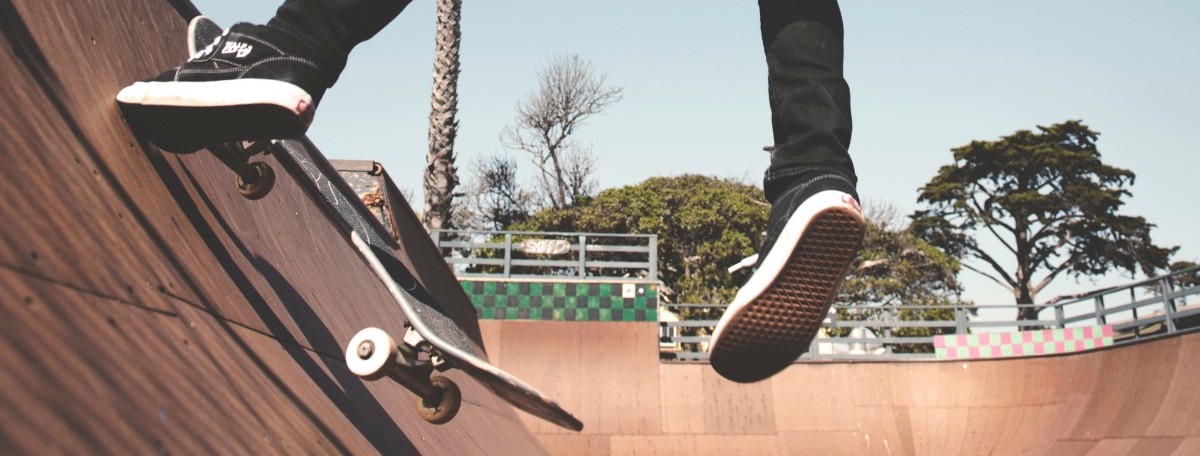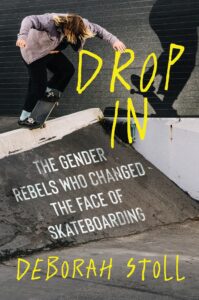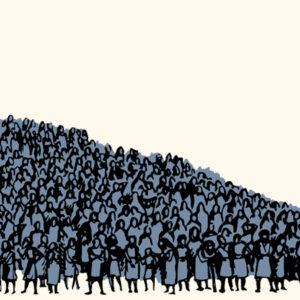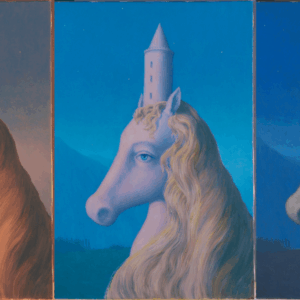
How a Generation of Women and Queer Skateboarders Fought for Visibility and Recognition
Deborah Stoll on Defying Gender Norms and Expectations in Extreme Sports
1975, Dogtown
Crumbling bungalows populated the narrow streets. Seussian cacti leached chlorophyll out of the sandy ground. Main Street, that ubiquitous American signpost of community, was a mosaic of boarded-up storefronts, liquor stores that opened sometimes, home to Willie the Gimp, Wheels the Wino, Tall Tex, and Magnificent Marko. And there, on the southeast corner of Bay and Main, was the Zephyr surfboard shop, the hyperbolized home of the inaccurately named Z-Boys—eleven boys and one girl: Peggy Oki.
It was April 1975, and all of the skateboarders who lived between the Sans—Diego and Francisco—were exhibiting their moves on the plywood course of the Del Mar Ocean Festival contest. Rolling handstands. Upright nose wheelies. Hippy jumps. Walking the dog. All of them unaware that the Z-Boys in their Salvation Army jeans and matching ringer tees were queuing up to skate fast and low to the ground, using their hands to flip around in jagged arcs and crouching aggressively on their boards, fingers flipped backwards, gripping the rails, hopping up and down on the urethane floor.
No contestant, juror, or curious bystander could have known that day would freeze-frame in history. Only self-described surfer/skater/writer/photographer/cultural anthropologist C. R. Stecyk III was prepared, pen poised, to spread the Z-Boys’ (widely fictionalized) “live fast/die young” gospel far and wide with hallucinatory, gonzo-style journalism.
What had once been a haven for outcasts, a space free from rules and regulations, had turned into an upside-down version of conformity.
There were the Z-Boys skating pools, shirtless, tube socks UP.
There were the Z-Boys lithe and tan, terrorizing old ladies as they exited the bus.
There were the Z-Boys posing with (fake) tigers. Flying on (private) airplanes. Oblivious to the (real) girls in shiny lip gloss dangling at their sides.
Parents didn’t exist. School was out forever.
As writer Joe Donnelly put it, “If you’re a kid with even a hint of cool, no matter what your age, you’re probably living in some version of 1970s Dogtown.”
But “cool,” when you dig below the surface, isn’t always “chill.” The aggressive male attitude that rose up out of the scene made it impossible to participate if you didn’t act like a Z-Boy.
So long, Shangri-la, and hello, hesh.
Suddenly skateboarding was just a guy thing. Zero percent a gay thing. What had once been a haven for outcasts, a space free from rules and regulations, had turned into an upside-down version of conformity.
Luckily, there was one person blissfully unaware of these goings-on. One person who didn’t know there were unwritten rules about who could skate and who couldn’t: Cara-Beth Burnside. In 1978, Cara-Beth (or CB, as she became known) was just a ten-year-old girl who loved roller skating. Then she walked into Big O in the O.C., where skaters ripped up and down snake runs (narrow, wind-y, concrete paths) and carved up the clover bowl (a four-leaf-clover-shaped pool of multiple depths), and she fell hopelessly in love with skateboarding.
“I started entering pro contests in the eighties as an ammmm and I was doing gooooood,” CB said, random words stretching like taffy, sentences never coming to a full stop. “But it was harrrrrd because a lot of the guys were so lame about it… I meannnnn, a lot of the guys were coooooollll, but there’s another type of guy that just couldn’t stand to watch you skate.”
In 1989, CB became the first woman to grace the cover of a skate magazine as Thrasher’s August cover girl. In a close-up shot against a blurred, high-speed background, CB’s sticking a frontside air with her tongue doing that thing you catch yourself doing in deep concentration—an unconscious curling under and pressing against her teeth, which most people would feel self-conscious about, but not CB. If you’re into it, cool. If not, get lost.
Her pink helmet matches the bottom of her board, which is also pink and covered in stickers—Thrasher, Independent, Vans, Swatch. Her left hand in a red fingerless glove grips her rail; her right arm wrapped in a purple wrist guard shoots perpendicularly out to the side. The headlines surrounding her promise an issue filled with pools, ramps, parks, and Jane’s Addiction. The name “Cara-Beth” is nowhere to be found.
Two years later, in 1991, CB was skating for Vans for $50 a month. Now she was a cover girl and had a sponsor, but she still wasn’t pro, so she still couldn’t make money since only pros got paid out at contests.
“I mean, maybe some people would have liked to pay me, but the guys wouldn’t have been stoked on that,” CB said. “But how long are you just… gonna, like… sleep at someone’s house?”
By the mid-’90s, snowboarding had become so popular, they were even letting women do it!
Just kidding. Women had been snowboarding all along, just under the radar. But by then, the top women athletes were earning up to $100,000 a year, with support from major brands like Burton and Sims.
“I was like, Okay, well…I can get good at snowboarding and travel the world and I can still skate,” CB realized. “All my girlfriends I snowboarded with were really supportive of that, and that’s what I needed…to just have a support system.”
So in 1995, CB, who at the time was the number-one female skateboarder in the world, turned herself into the number-two female snowboarder in the world.
In the world.
In 1996, she won the big air competition at the U.S. Open. In 1997, she took home silver in slopestyle at the winter
X Games.
In 1998, she finished fourth on the half-pipe as a member of the first-ever Olympic snowboarding team.
And in 1999, she became the first woman to receive a pro-model skate shoe from Vans, because, of course, she was still skating.
And maybe it was the shoe that did it. The navy-blue suede with orange and red suns on the heels, and her initials, CB, stacked off-center in the middle. Maybe that’s when she was like, Yeahhhhh…mountains are cool and all, but I need a skate crew. So in 2000, CB focused her energy on convincing every female vert skater she met to move to San Diego.
Her first recruit was Jen O’Brien.
“I remember me and Jodi [McDonald] drove out to San Francisco in the Glug Bus for the Back to the City competition,” said Jen, referencing the forty-foot school bus she and her friends tricked out for skate trips and named after their preferred way of consuming beer. “I met CB and we were just a match made in heaven.”
But it’s also possible they met at the Happy Land Bowl in San Diego.
“I remember the guys were like, Oh, these girls Jen and Jodi are from Florida and they’re skating, and I was like, Okay, whatever, because people would always tell me that about girls, but usually they’re just doing a couple kickturns and then chilling for the rest of the time…but Jen was in the session…she was carving and going fast and doing backside ollies over these hips, and I was like, What the hellllll?”
The next two recruits were Northwest pool skaters, Kim Petersen and Jessica Starkweather, who traded their hometown’s relentless cold and rain for the equally relentless sun and surf. And for a while, everyone was living the dream. Whenever they weren’t bartending or nannying, they were snowboarding at Big Bear for free as “CB’s assistants,” driving back in time to skate Chickens, then heading south to Huntington Beach to hang with Christian Hosoi.
“Christian was the man back then,” said CB. “He would always be super respectful when we’d show up: Oh shit, look out, here come the girls, they’re gonna do tricks that I can’t even do! It’s cool to have somebody say things like that, you know?”
“Christian was a rock star,” Jen concurred. “We’d go to clubs with him and they wouldn’t even check my ID. There was one time that me, CB, and Jodi were playing pool and just getting rowdy. We had this thing, break something! And then we’d smash bottles. This girl was like, You’re gonna clean that up! And CB told her to leave me alone. Things got a little pushy and CB ended up breaking her nose.”
Jen stopped to laugh at the memory of all that blood and how the girl CB clocked had just been released from prison. “Like I said, me and CB were a match made in heaven.”
In 2001, another match made in heaven arrived in the form of a twenty-three-year-old bartender/skateboarder named Mimi Knoop. Mimi, whose dad was in the Navy, had moved around a bunch—from Virginia, to Cuba, to Cincinnati, to the Virgin Islands—and in each place she lived, she’d found someone to skate with.
“[In Virginia] one of the kids I played with in the neighborhood, I was probably six or seven, he rolled up with a Nash skateboard from Toys R Us and I’m like, What is that thing?” Mimi recalled. “I just fell in love with the feeling the first time I tried it, and that was it.”
Later, in Cuba, a kid who lived down the hill shared his Bones Brigade videos with her and unlocked a whole new box of knowledge.
“Up until that point, you see a photo of a trick in a magazine, and you don’t really know how they got in that position,” Mimi said. “Seeing everything in action for the first time blew our minds. We were just obsessed after that.”
One thing Mimi never considered was the possibility that there were other girl skaters out there. She’d never seen one in real life. She’d never seen one in a video or magazine. It wasn’t until she saw a woman flying over the coping of a bowl on an X Games TV promo that she realized other women skated. And not only skated, but skated professionally. And that’s when she knew she’d wasted her life.
“I thought, Too bad I didn’t get into it ten years ago,” Mimi said. But life happens in inexplicable sequences. Things we think we’ve missed, opportunities we’re certain have passed us by, have a way of materializing unexpectedly.
So it was that months after realizing her folly, Mimi found herself living in Southern California, skating at her new local, when she saw the woman from the X Games clip a few feet away. It seemed completely implausible, like a contrived plot point, except it was real life, and CB invited Mimi to hang out with her and her friends. They showed her how to drop in on the mini ramp, and, days later, convinced her to enter her first contest.
“At that time, if you placed in the top five you’d win money,” Kim said. “Dave Duncan would go, ‘Okay, here’s $250, now you’re pro!’”
Mimi took fifth at that first contest, and, according to Dave Duncan, was “pro.”
*
It’s often difficult to say what draws you to a person. There are obvious tells, like you have the same taste in bands, you read the same books, you both love to skate… but there are unseen things too, elusive something-somethings that connect you in a way that isn’t romance and isn’t friendship, but something in-between. CB had sessioned with a handful of skaters over the years and those times had been cool. Awesome, even. But when Mimi showed up, things coalesced in a way they never had before, and as a result changed both of their lives and the lives of dozens of girl skaters around the world.
One of them was Alana Smith.
*
November 3, 2012, San Diego, California
Clairemont Skatepark
Twelve-year-old Alana stood at the top of the vert ramp, her wheels clipped against the coping. She stared into the middle distance and pictured herself holding the toeside of her board between her feet with her front hand while rotating one and a half times in midair before landing on the wall of the ramp in a forward-facing stance.
There was just one thing: no woman had ever landed a McTwist in a contest.
As the trick’s namesake, vert skater Mike McGill, watched from the opposite deck, Alana checked her kneepads, shook the nerves out of her hands, placed her right foot just behind the bolts on her board, ducked her head, and dropped in. The moment her tail crested the coping, her right hand grabbed the middle of her board as her left arm rose up to guide her body one full rotation, head swiveling to keep an eye on her mark. When she landed, her torso retracted like she was sucking in her stomach, hands splayed out in front.
It was a clean backside air.
She landed a second backside air. Then a third backside air.
And at the top of what would be her fourth, Alana spun around once, then another half turn, sticking the landing so casually it took a full three seconds before the crowd realized what she’d done. And then they screamed.
At twelve years old, Alana had just become the first girl to land a McTwist in competition.
It was a record-breaking win for her. A boundary-breaking win for women skaters. And a course-correcting win for a recent college grad named Amelia.
*
May 26, 2011, One and a half years earlier
Amelia Brodka’s dreams were smashed to smithereens.
After years of skating, of pushing her progression every moment she wasn’t in class at USC, where she was double majoring in communication and narrative studies, Amelia had finally heard the words she’d dreamed of hearing for so long—There’s an X Games invite with your name on it!
A second later she was told that women’s vert skating at X Games was canceled.
Amelia couldn’t make sense of it. There were more women skating than ever before. And not only that, but X Games was the sole contest for female vert skaters. Why would they take away the skaters’ one chance to compete and grow their numbers? And what the heck was she supposed to do now that her entire life’s plan had gone up in smoke??
That summer, back home in New Jersey, Amelia spent her days alternating between feeling mad and sad. Mad and sad. Mad mad mad. Sad sad sad. She called her friends and skulked around until—
“I was with this photographer, Julian Bleecker,” Amelia recalled. “We were going to shoot some skate stuff and one of us said something like someone should make a documentary about this. Then he goes, Why don’t you make it? And I laughed. Yeah…okay…I don’t even own a camera.”
But weeks later, Amelia found herself thinking about it. She’d grown tired of sitting around feeling sorry for herself and needed to understand what was going on. So, armed with a recording app on her iPhone and a tripod her dad MacGyvered out of a belt clip and superglue, Amelia started interviewing people she knew in the skate industry. Brand managers, magazine editors, young skaters, OGs…
“Why don’t we see girls skating in the magazines?” she asked them.
“Why is there a level gap between men and women skaters?” she wanted to know.
“How can women who don’t skate contests get exposure?” she pressed for answers.
Every time she spoke to someone in a position of power, Amelia would plead her case. “Our numbers in the past five years have grown exponentially!” she’d say. “Look at the participation numbers!”
Things coalesced in a way they never had before, and as a result changed…the lives of dozens of girl skaters around the world.
At summer’s end, Amelia flew back to California to start her senior year and continued the project, renting a camcorder from school and lugging it around to film her interviews. She didn’t know how to “light her subjects.” It took forever to learn how to position a mic close enough to avoid picking up ambient sounds but not so close you could hear every rustle of someone’s pants when they crossed their legs. Mostly she pressed “record” and “stop” and sometimes “pause,” but still, video brought the project to life in a way the voice recordings never had. Which gave her a great idea.
*
“A feature-length film?” her department head intoned warily. He was gaunt. His hair was gray. He wore thick, black-rimmed glasses.
“Yes,” Amelia confirmed. Her independent senior project was going to be a documentary about women in skateboarding.
“What about twenty minutes?” he suggested.
Twenty minutes, Amelia thought. I’ll show him twenty minutes. “It’s going to be a feature,” she asserted.
“I have no idea where I got that confidence,” Amelia admitted later. “I had no clue what I was doing.”
*
One week later, Amelia was working on her run in the clover bowl at the Fontana Skatepark. Her arms moved nonstop—bending at the elbows, twisting with her torso, alternating which was leading, like a boxer switching stances. Pausing to chug some water, she noticed a guy nearby filming. In the days since she’d announced she was making a movie, she’d been wondering if it hadn’t been a colossal mistake.
Amelia popped out of the bowl and approached the filmer. “Hi! That’s a cool camera! What, ah, settings are you using?”
“I kept asking him things and not using the right words.” Amelia laughed. “He was like, You seem very curious about what I’m doing. I told him I was making a documentary and I don’t really know anything, so I’m trying to learn.”
The filmer, whose name was Brian, invited Amelia to trail him the rest of the afternoon, explaining what each piece of gear was and why he was using it. He pointed out settings on Amelia’s camera she might find useful, and, on his way out of the park, yelled, “If you ever need a B-cam, let me know!”
B-cam, Amelia thought. I’m gonna have to look that one up.
A few weeks later, Amelia was filming her friend and ex-pro skater Hunter Long at The Cove in Santa Monica, or, at least, attempting to, when—
“Want some help?” Amelia looked up to see Brian standing next to her, smiling. Within minutes, they were rolling, and within days, they were making a movie.
*
Clocking in at an hour and twenty-six minutes, Amelia’s documentary, Underexposed, premiered at the Agenda trade show in Long Beach in 2012. In it, a who’s who of the skateboarding industry offer their takes on why the girls’ skate market is so undeveloped: CB, Mimi, and Elissa Steamer. Christian Hosoi, Lance Mountain, and Steve Caballero. Toy Machine’s Ed Templeton, Thrasher’s Michael Burnett, representatives from Osiris and Transworld Skateboarding. And woven in between them all is Amelia’s own personal story.
“I wanted a way to show people that women’s skateboarding is a rapidly growing scene, with girls pushing the level of their skating every day,” Amelia said in an interview with ESPN, the cable TV behemoth that owns the X Games franchise. “I wondered what it was about the way the skate industry works that kept companies from seeing it as an opportunity to tap into a growing market.”
Underexposed stands, a decade later, as the only exhaustive exploration of girls skateboarding on film, a critical piece of history offering insight into the road that female, gay, trans, bi, and nonbinary skaters had to travel to claim space.
The film Underexposed led to the creation of the Exposure skate contest. Cofounded by Amelia and Lesli Cohen (who also cofounded the first women’s roller hockey team, which resulted in the development of a national women’s league), Exposure went on to become an extensive nonprofit with year-round programming, as well as the largest annual skateboarding competition inclusive of girls, women, and trans and nonbinary people from all over the globe. At the 2021 Olympics, more than half of the competitors who identified as women or nonbinary had participated in at least one Exposure event, and for many, it launched their competitive careers.
Alana Smith pioneered this group by landing a McTwist at the first-ever Exposure contest and then, years later, by becoming the first openly nonbinary athlete at skateboarding’s inaugural Olympic competition.
__________________________________

From the book Drop in: The Gender Rebels Who Changed the Face of Skateboarding by Deborah Stoll. Copyright © 2024 by Deborah Stoll. Reprinted by permission of Dey Street Books, an imprint of HarperCollins Publishers.
Deborah Stoll
Deborah Stoll is a journalist, lyricist, writer and animator. Her work has appeared in The Economist, Los Angeles Times, LA Weekly, Portland Mercury, San Francisco Chronicle, Punch Drink, Buzz Bands, Ignite and White Hot Magazine. Her short stories have appeared in Slake, Swivel, and Fresh Yarn. Her band, Hot As Sun, has opened for Phantogram, Gotye, and Foster the People, been featured on TV shows like Vampire Diaries, Pretty Little Liars, Glee, and CSI: Miami and in the movie For a Good Time, Call and the upcoming, Space Cadet. Her first book, Unvarnished, was co-written with Eric Alperin. Drop In is her first book as a solo author.












